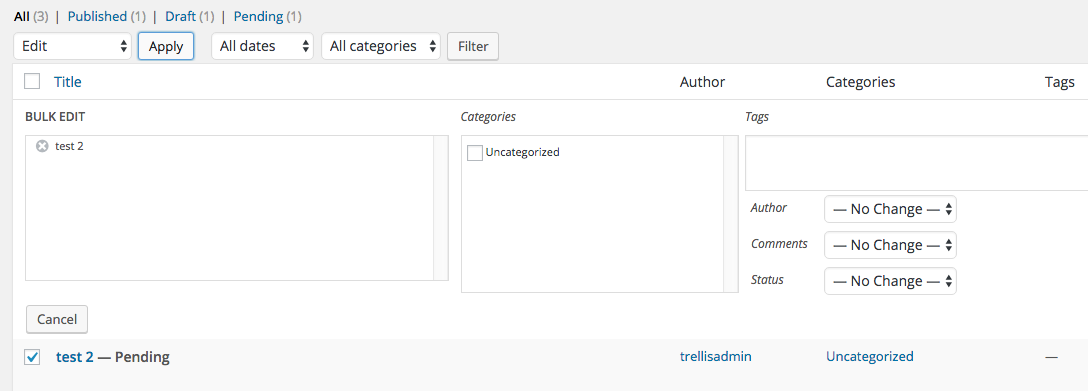Managing Posts in WordPress
Isaiah Bollinger
Isaiah Bollinger
WordPress roots began with its publishing and blogging capabilities. Posts are the driver of such capabilities. It has since grown into a full blown CMS, powering massive websites around the world and is no longer simply a blogging platform. However leveraging posts and knowing how to use them will most likely be a crucial part of managing your WordPress website. This blog is meant to help anyone new to WordPress learn how to manage posts in the admin panel.
Posts listings:
The posts part of the WordPress admin panel are most likely going to be the staple of your blog and even potentially your entire WordPress website. They can be found at the top left below the dashboard in the left admin panel menu area. There is also the ability to add a new post via the top +New button as well. When you click on posts you can see all the posts you have and view 20 at a time.

Bulk Edit:
A great feature of WordPress is the bulk editing tool. This is especially helpful if you are updating a bunch of posts and assigning them to a new category. You can bulk change posts author, comments, status, categories and tags. This could save you a tremendous amount of time if you are making bulk changes to many posts.

Quick Edit:
Quick edit is a useful feature if you want to make a quick change to one of your posts meta data. For instance if you want to change the slug which controls the URL of the post you can quickly do so without having to go into the actual post itself. Quick edit is a great tool for updating things like titles, categories, slugs, and the status of the post itself such as draft or pending.

Posts Page:
The post page itself is where you are going to spend more of your time. The Title is as it seems which is the name of the actual post. Depending on how you have your permalinks setup the title will control the initial permalink, but you can go in and edit the link itself if you want to change the URL of the post.
Wysiwyg:
Just like the pages section of WordPress you will spend the bulk of your time in the Wysiwyg editor. With the add media button you can easily add new images or existing images to a post and you will see that image in the Wysiwyg editor. You can actually click on that image in the editor and edit it if you want to change how it appears.
The default Wysiwyg editor allows you to easily make text bold, italic, crossed out, bulleted, quoted, add a horizontal line, left align text, center text, or right align text. You can also add a link, remove a link, or add a read more tag for where you want content to be cut off on a blog listing page.
If you select the toggl botton on the top far right you have even more options. Here you can change your paragraph to different headers, underline text, justify text, change the text color, paste as text, clear formatting, add a large list of special characters, decrease or increase indents, undo or redo, and see all the short cuts.
This is a lot of power to control the content on a page without any actual coding expertise which is part of what makes WordPress so useful.

Publish:
The publish section is necessary for managing the status and publications of your posts. You can create a new post and save it as a draft. You can then save it to pending if you want it to be reviewed or go beyond the draft stage. You can also schedule a post if you edit the publish immediately section and pick a date and time to schedule the post. Another tool that is helpful is the ability to view old revisions. Lastly you can set the visibility to a non public setting if you do not want to use it for that purpose.

Format:
By default WordPress has several formats including, Standard, Aside, Gallery, Link, Image, Quote, Status, Video, Audio, and Chat if you want to change the format of your post. The look and feel of this will depend on the theme you use and how you built your post page to look like.
Categories:
Categories are an important part of your posts because they control the way your posts are grouped. You may even have individual pages or become a part of your actual main navigation, depending on how your site is structured. You can control the slug and name of the category as well as assign categories to be parents of other sub categories.

Tags:
Tags are similar to categories but are typically meant for more specific information regarding a post. So a category might be something like “business” and a tag might be something like “executive responsibility” or a more specific subset of business.

Featured Image:
The featured image is at the bottom right hand side of the post page. This can be used to feature an image at the top of a post when published or on the post listing page to display images associated with each post. This will largely depend on how your theme decides to utilize the featured image functionality of posts.
Plugins & Custom Features:
Plugins like Yoast SEO and Advanced Custom Fields can add significant functionality to what the default posts page can do in WordPress. There are many ways to add significant functionality to what posts can do by utilizing the over 30,000 plugins on WordPress.org or even create custom functionality that no one else has!
